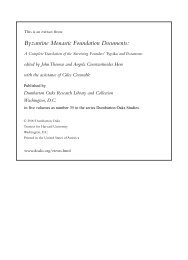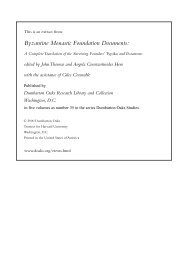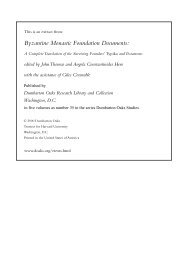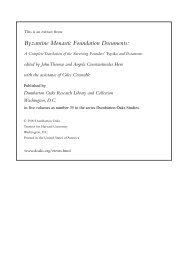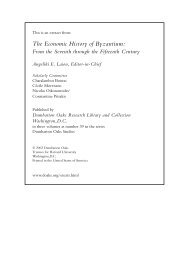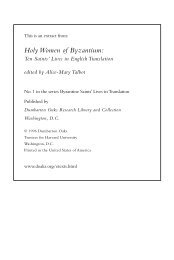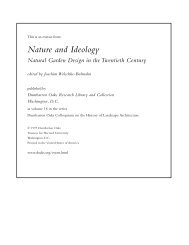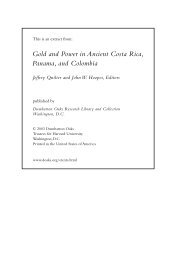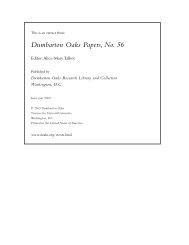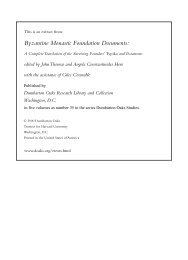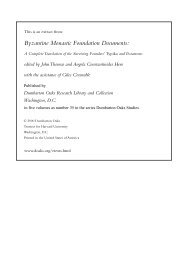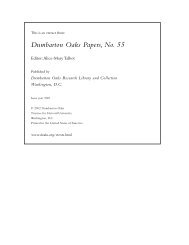The Zooarchaeological Record from Formative ... - Dumbarton Oaks
The Zooarchaeological Record from Formative ... - Dumbarton Oaks
The Zooarchaeological Record from Formative ... - Dumbarton Oaks
Create successful ePaper yourself
Turn your PDF publications into a flip-book with our unique Google optimized e-Paper software.
<strong>The</strong> <strong>Zooarchaeological</strong> <strong>Record</strong> <strong>from</strong> <strong>Formative</strong> Ecuador<br />
wet habitats like mangroves, estuaries, lagoons, and swamps. Conceivably, they<br />
used nets or some form of projectile. Similarly, forest forms, including tinamous,<br />
currasows, and a variety of small, brilliantly plumed birds could have been stalked<br />
in canopied forests, where a host of terrestrial, scansorial, and arboreal mammals<br />
could also have been hunted. It is interesting to speculate on the way in which<br />
certain arboreal taxa were obtained, especially those sloths and primates who<br />
spend much of their lives in high canopy. This could implicate projectile weapons<br />
like bows and arrows, spear throwers (e.g., Lathrap et al. 1975: 105), or even<br />
blowguns. Recent Tsátchela of the western lowlands included blowguns with<br />
clay pellets in their arsenal (Métraux 1963: 251). <strong>The</strong> Chachi of Esmeraldas<br />
province are known to have employed the poisonous darts essential for relaxing<br />
the death grip of certain arboreal game (Murra 1963: 280).<br />
Significantly, different kinds of open habitats are represented in the list of<br />
<strong>Formative</strong> archaeofauna. Access to semiarid landscapes may be suggested by<br />
the commonly encountered remains of Dusicyon sechurae, which is found in the<br />
desertic, yet highly labile environment of the southwestern coast. Forested habitats<br />
of the páramo are suggested by the remains of the mountain tapir, as are<br />
highland grassland habitats by the late appearance of domesticated camelids.<br />
Much has been made of the feeding preferences of the white-tailed deer. <strong>The</strong>se<br />
browsers tend to thrive in edge environments, and, as most suburban gardeners<br />
can attest, flourish in and around areas cleared for crops. Nevertheless, the whitetailed<br />
deer and its close allies tend to dominate the profiles of prehistoric food<br />
fauna in practically every archaeological context that does not include domesticated<br />
animals. Indeed, many of the taxa in Table 3 can be described as ecological<br />
generalists, especially opossum, armadillo, various raccoons, peccary,<br />
certain rodents, and rabbits. Usually, when flotation recovery of lowland archaeological<br />
deposits is employed, remains of the rice rat tend to be common<br />
to ubiquitous. Hershkovitz (1960: 527–528) has noted that species of Oryzomys<br />
can become markedly commensal with humans through residence in roof thatch.<br />
Certain pastoral rodents like grass mouse and cotton rat include croplands in<br />
their range of exploited habitats, as do doves, parrots, and toucans.<br />
Anthropogenic manipulation of animal populations is evident in the recovery<br />
of domesticated taxa. Domesticated dogs have been identified <strong>from</strong> early<br />
<strong>Formative</strong> contexts in the coastal lowlands. <strong>The</strong> notorious difficulty in using<br />
incomplete skeletal remains for discriminating amongst the various canids is<br />
mitigated through the infrequent recovery of intentional dog burials. <strong>The</strong> interment<br />
of domesticated dogs might explain why so few canine remains are<br />
found in Early <strong>Formative</strong> midden contexts. Dogs may certainly have possessed<br />
a variety of cultural roles as hunters, protectors, and sustenance. Some time ago,<br />
187




